Top WhatsApp Marketing Automation Tools Every D2C Brand Needs
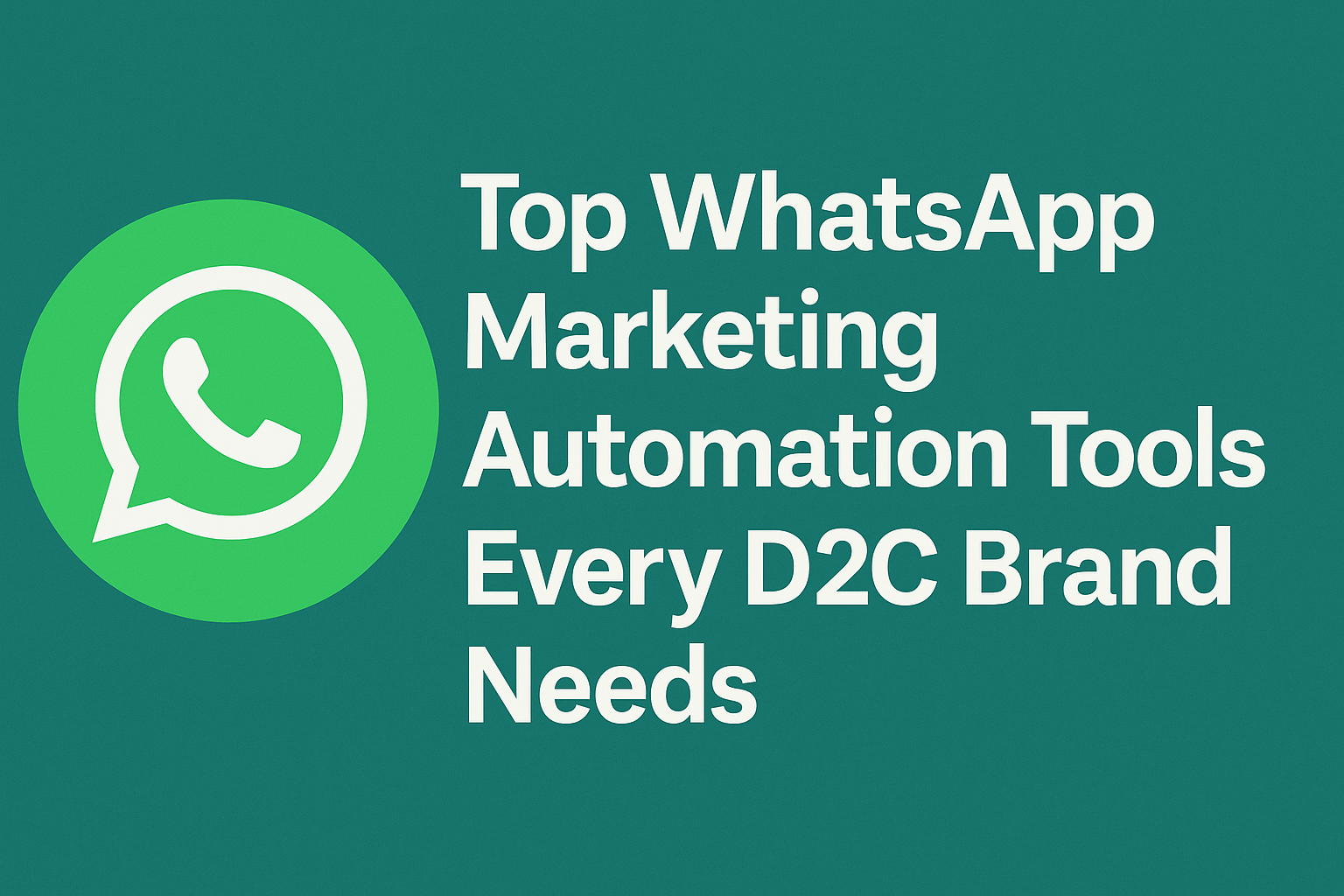
Introduction WhatsApp is now the most powerful direct-to-consumer channel—with 98% open rates and real-time delivery. But it’s not just about sending messages; it’s about building meaningful customer journeys. That’s where The Bot Mode steps in. Designed for D2C brands, The Bot Mode offers end-to-end WhatsApp marketing automation, converting conversations into conversions with ease. In this blog, you’ll explore why The Bot Mode is the must-have automation tool for WhatsApp marketing and how it stacks up against generic platforms. Why WhatsApp Marketing Automation is Vital for D2C Brands Key Features of The Bot Mode for D2C Brands Use Cases: How D2C Brands Win with The Bot Mode Why The Bot Mode Outperforms Traditional WhatsApp Tools Feature The Bot Mode Generic Tools D2C Specialization ✅ Yes ❌ No Built-in eCommerce Flows ✅ Shopify/WooCommerce Ready ❌ Limited integrations Smart Chatbot Builder ✅ NLP & AI powered ⚠️ Basic templates Campaign Automation ✅ Drip, Segmented ⚠️ One-time blasts Compliance Support ✅ GDPR-ready ⚠️ Requires manual setup Best Practices to Maximize The Bot Mode’s Impact Future Trends in WhatsApp Marketing You Can Leverage with The Bot Mode Conclusion For D2C brands, WhatsApp is more than a messaging app—it’s a full-fledged conversion channel. The Bot Mode offers the automation backbone you need to scale customer communication, increase conversions, and reduce support costs. Whether you’re just launching or scaling globally, The Bot Mode adapts to your growth and elevates your marketing game. FAQs Q1: What makes The Bot Mode ideal for D2C?It’s tailored for commerce—from cart recovery to reorder flows, all automated. Q2: Can I personalize my WhatsApp broadcasts?Yes, using tags like {{name}}, {{order_id}}, etc., within The Bot Mode. Q3: Is The Bot Mode API-based or no-code?Both. You can use its visual builder or API for deeper integrations. Q4: How fast can I go live?Most brands are up and running in under 72 hours. Q5: Is it GDPR-compliant?Absolutely. The Bot Mode follows all major data privacy protocols.
From Chat to Checkout: Optimizing Your WhatsApp Product Catalog
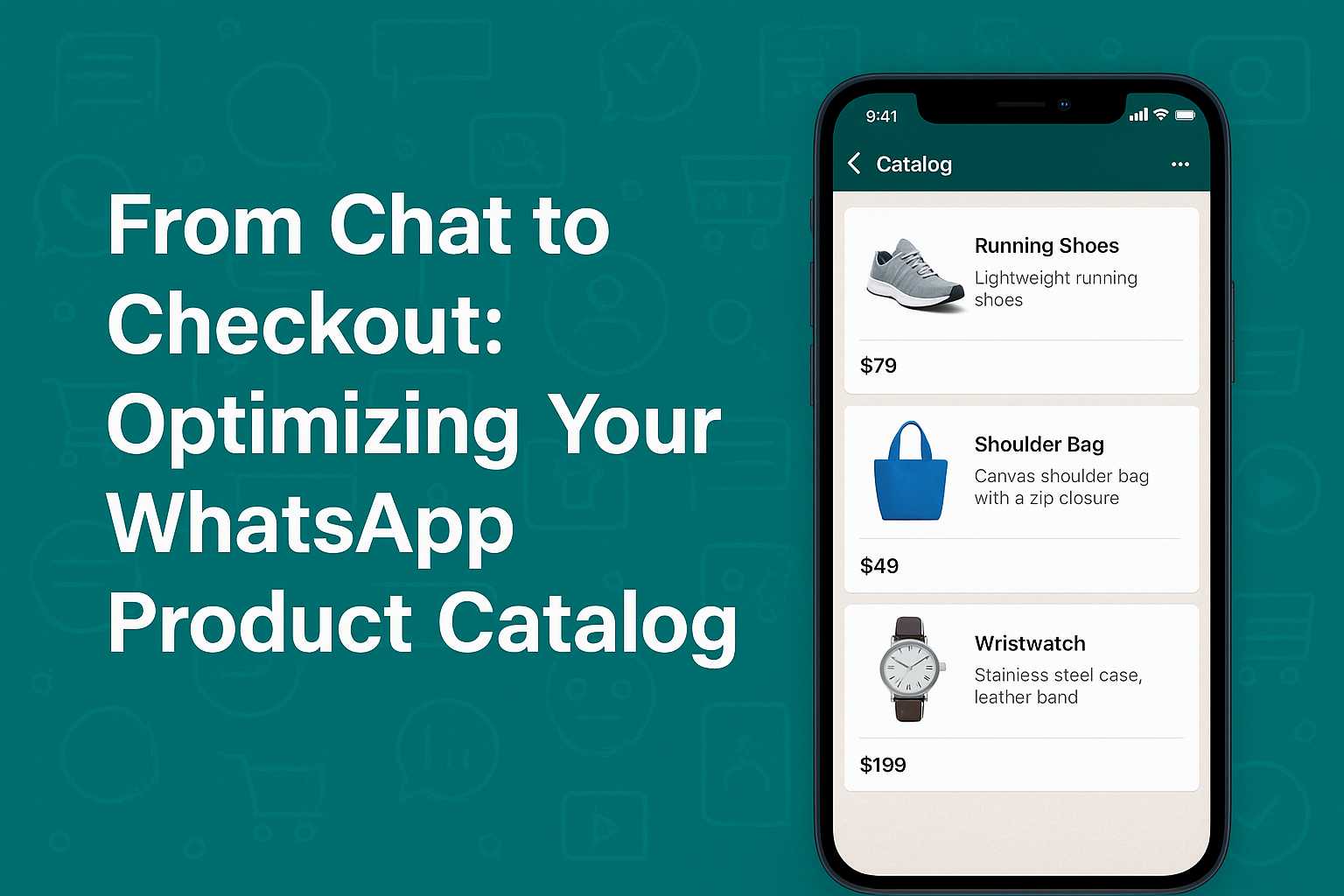
Introduction The way consumers shop is evolving rapidly, and conversational commerce is leading the charge. With over 2 billion users worldwide, WhatsApp Business offers a powerful tool for brands to showcase products, streamline discovery, and close sales—all within a single conversation. For modern businesses aiming to boost traffic and increase conversions, an optimized WhatsApp product catalog is no longer optional—it’s essential. What Is WhatsApp Product Catalog? WhatsApp’s product catalog is a built-in feature of WhatsApp Business that allows businesses to display up to 500 products or services. Each item includes: It acts as a mobile storefront, offering customers instant access to your products without leaving the app—making browsing and buying easier and faster. Why Your Business Needs an Optimized Catalog An optimized catalog helps you: In short, your catalog isn’t just a product list—it’s a conversion tool. Step‑by‑Step: Set Up with SEO & Voice‑Search in Mind 1. Access & Create Your Catalog Navigate to:WhatsApp Business > Business Tools > Catalog > Add New Item You can add items manually through the app or use WhatsApp Business Manager on desktop for larger uploads. 2. Prepare Optimized Assets 3. Publish & Get Approved WhatsApp auto-reviews your entries. Common rejections include: Keep descriptions honest, and re-upload any rejected content with corrections. Pro Tips: Optimize for Traffic & Conversions AEO & Voice‑Search Enhancements To rank for voice search and featured snippets: These steps align with how Google’s RankBrain and BERT algorithms understand natural language. Integration with The Botmode At The Botmode, we help businesses supercharge their WhatsApp catalogs by automating: Pairing your catalog with smart automation creates a seamless end-to-end experience—from chat to checkout. Conclusion Optimizing your WhatsApp product catalog is more than just an enhancement—it’s a strategy. From cleaner layouts to smarter automation and voice search readiness, each optimization step builds toward higher engagement and sales. Start crafting your catalog today and let The Botmode help you unlock its full power. FAQs 1. What is the maximum number of products I can add? You can add up to 500 products or services to your catalog. 2. How do I organize products into collections? Use the “Collections” feature in WhatsApp Business Tools to group related items for easier browsing. 3. Can I hide products temporarily? Yes, products can be marked as “Out of Stock” or unpublished without deleting them. 4. Will WhatsApp review my images? Yes, every product undergoes automated review to ensure it meets community guidelines. 5. How to share my catalog outside WhatsApp? You can share your catalog link via your website, email, social media, and QR codes.
Post-Purchase WhatsApp Workflows That Drive Repeat Sales
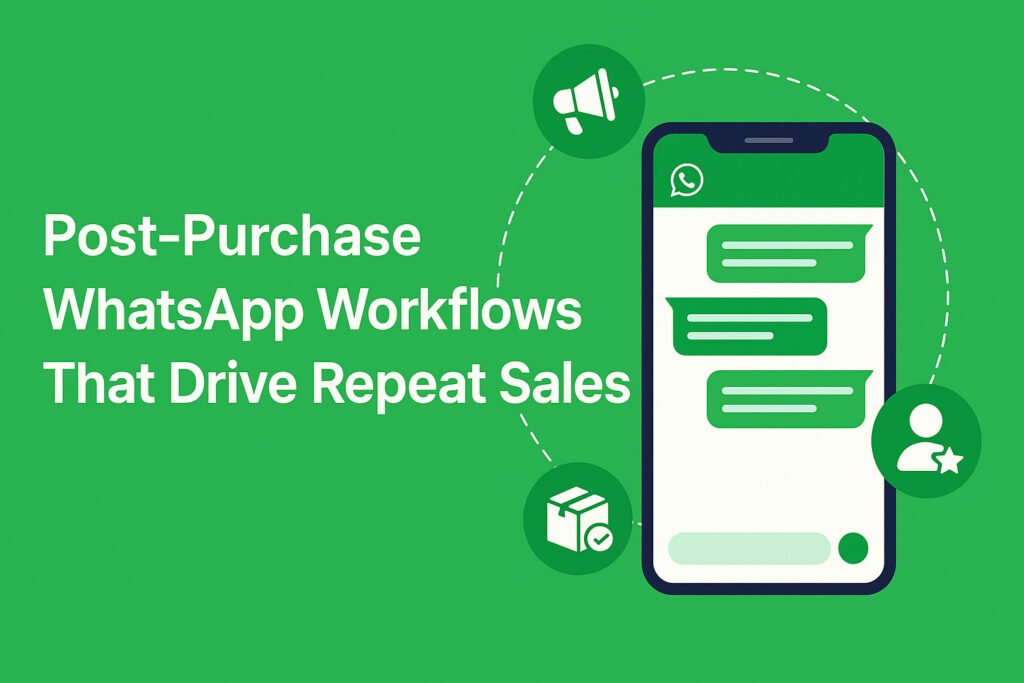
Why Post-Purchase WhatsApp Workflows Matter for D2C Brands The customer journey doesn’t end after checkout—it evolves. For D2C brands, the post-purchase phase is a golden window to build loyalty, foster engagement, and trigger repeat purchases. WhatsApp, with its 95%+ open rates and real-time delivery, is the perfect channel to connect with customers after the sale. Compared to email, WhatsApp offers: Done right, post-purchase WhatsApp automation keeps your brand top-of-mind and increases lifetime customer value. 7 Must-Have Post-Purchase WhatsApp Workflows 1. Order Confirmation & Thank You Send an immediate WhatsApp message once the order is placed to confirm details and express gratitude. Trigger: Order placed → Instant WhatsApp confirmation 2. Shipping & Delivery Updates Automate tracking updates across the delivery journey to reduce WISMO (Where Is My Order) queries. Workflow: Order dispatched → In-transit → Out for delivery → Delivered 3. Feedback & Review Request Gather insights and build credibility by asking for feedback shortly after delivery. Trigger: Order delivered → After 2 days → WhatsApp message with review link 4. Product Usage Tips or Guides Help customers maximize their purchase with how-to tips, usage guides, or styling ideas. Trigger: Order delivered → After 3 days → Tips via WhatsApp 5. Cross-Sell & Upsell Suggestions Leverage purchase history to suggest complementary or upgraded products. Trigger: Order delivered → After 7 days → Personalized product recommendations 6. Replenishment Reminders Perfect for consumables or recurring needs. Automatically remind customers when it’s time to reorder. Trigger: 30 days after purchase → WhatsApp reminder to restock 7. Loyalty & Rewards Notifications Celebrate loyal customers by sending exclusive rewards, offers, or loyalty program updates. Trigger: Customer completes 2+ orders → WhatsApp reward message How TheBotMode Automates These Workflows TheBotMode simplifies WhatsApp automation for D2C brands with: Pre-built post-purchase templates1-click integration with Shopify, WooCommerce & moreSmart segmentation for hyper-personalized outreachReal-time performance analytics You can set up complex workflows in minutes—without writing a single line of code. Best Practices for Post-Purchase WhatsApp Automation Final Thoughts Winning the first sale is just the beginning. With well-designed post-purchase WhatsApp workflows, you can delight customers, reduce support tickets, and increase repeat purchases—all on autopilot. Start automating your post-purchase journeys today with TheBotMode—and turn one-time buyers into loyal brand advocates. FAQs: Q1. What is a post-purchase WhatsApp workflow? It’s an automated series of messages sent via WhatsApp after a customer makes a purchase—used to update, engage, and re-sell. Q2. Can small D2C brands benefit from this? Absolutely. Platforms like TheBotMode make it easy for small teams to implement these workflows with minimal effort. Q3. Are these messages allowed under WhatsApp’s API policies? Yes, provided you use approved templates and secure opt-in consent from customers. Q4. When should I start sending post-purchase messages? Begin with instant confirmation and continue with updates and feedback requests spread over a few days to weeks. Q5. How do I track results? TheBotMode offers built-in analytics to track opens, clicks, responses, and conversion data.
WhatsApp Campaign Metrics: How to Track Clicks, Conversions, and ROI
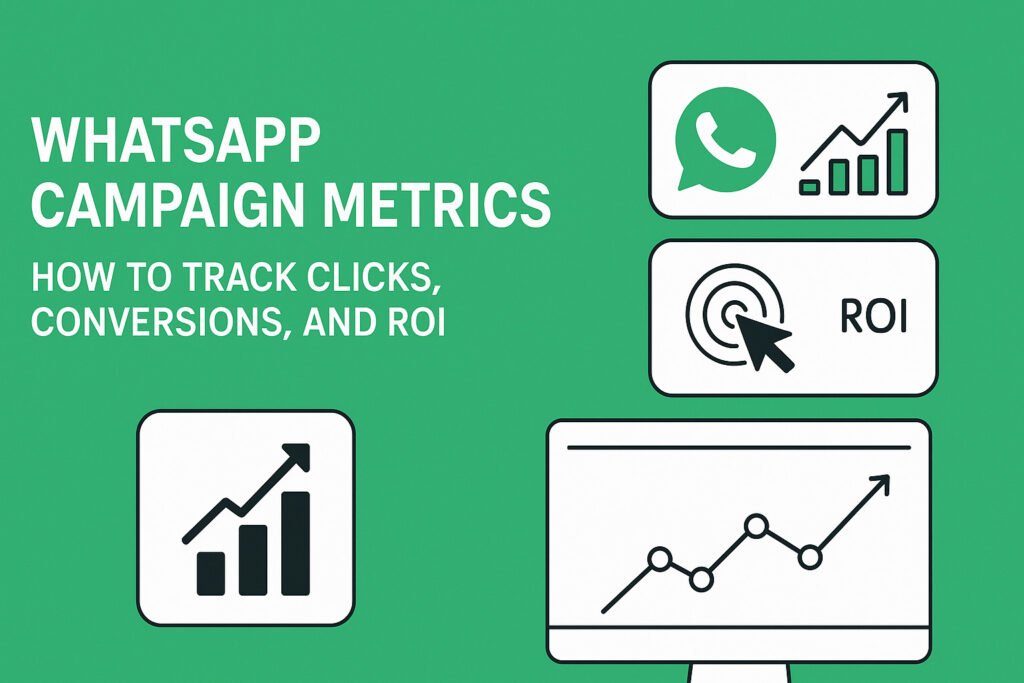
WhatsApp has emerged as a powerful growth channel for D2C brands—offering unmatched reach, high engagement, and direct conversions. But sending messages alone isn’t enough. To drive meaningful results and scale your marketing efforts, you need to understand what’s working and what’s not by tracking the right campaign metrics. In this blog, we’ll break down the essential WhatsApp metrics every brand should track, how to track them effectively, and how TheBotMode can help you unlock smarter, data-driven campaigns. Why WhatsApp Campaign Metrics Matter for D2C Brands Tracking campaign metrics is not just about reporting—it’s about improving performance. With clear insights, you can identify: Without this visibility, you’re just guessing. Key WhatsApp Campaign Metrics You Should Track 1. Delivery Rate Formula:(Delivered Messages ÷ Total Messages Sent) × 100 Why It Matters:A low delivery rate may indicate poor contact data, unverified numbers, or opt-in issues. 2. Open Rate The percentage of delivered messages that were opened by recipients. Why It Matters:WhatsApp typically sees open rates above 95%. If yours is lower, your timing or content may need adjustment. 3. Click-Through Rate (CTR) Formula:(Link Clicks ÷ Delivered Messages) × 100 Why It Matters:CTR reveals how compelling your message is. Use UTM-tagged links to get accurate click data via Google Analytics or TheBotMode dashboards. 4. Conversion Rate Formula:(Conversions ÷ Link Clicks) × 100 Why It Matters:This is your key performance indicator. It tells you if users are taking meaningful actions after clicking, like making a purchase or signing up. 5. Opt-Out Rate Measures how many recipients unsubscribed after receiving your message. Why It Matters:A high opt-out rate signals poor targeting or over-messaging. Monitor this to protect your sender reputation. 6. Response Rate For two-way campaigns, this tracks how many users replied to your message. Why It Matters:This metric helps assess engagement quality and audience trust. 7. WhatsApp Campaign ROI Formula:(Revenue – Campaign Cost) ÷ Campaign Cost × 100 Why It Matters:This is the most business-critical metric. If ROI is low, revisit your messaging, targeting, or offer. How to Track WhatsApp Campaign Metrics Effectively 1. Use UTM Parameters for Links Always add UTM tags to your campaign URLs. This allows you to attribute traffic, engagement, and conversions within Google Analytics. Example:https://yourstore.com/product?utm_source=whatsapp&utm_medium=campaign&utm_campaign=summer_sale 2. Enable WhatsApp Business API Analytics With TheBotMode’s WhatsApp API, you can track: This gives you full control over your messaging performance. 3. Connect WhatsApp with Your Store Using TheBotMode’s Shopify or WooCommerce integration, you can: 4. Use Campaign Dashboards TheBotMode provides dashboards where you can: WhatsApp Campaign Benchmarks for D2C (2025) Metric Industry Benchmark Open Rate 95%+ Click-Through Rate 10%–20% Conversion Rate 5%–10% Opt-Out Rate Below 1% ROI 5x–10x (Varies by niche) Source: TheBotMode internal customer data (2025) Conclusion Great WhatsApp marketing isn’t just about sending messages—it’s about continuously learning from your data. By tracking key performance metrics, D2C brands can fine-tune their messaging, improve conversion rates, and generate better ROI from every campaign. TheBotMode gives you the tools to do exactly that—track, measure, and scale with confidence. FAQs Q1: How can I track clicks on WhatsApp messages?Use UTM-tagged links and track click data in Google Analytics or TheBotMode’s dashboard. Q2: What’s a good WhatsApp conversion rate for D2C brands?A strong conversion rate is between 5% to 10%, depending on your offer and audience. Q3: Can I track revenue from WhatsApp campaigns?Yes, by integrating TheBotMode with Shopify, WooCommerce, or CRMs, you can see direct revenue attribution. Q4: What’s the average ROI from WhatsApp campaigns?Most brands see 5x–10x returns, though results vary based on targeting and content quality. Q5: Does TheBotMode offer in-depth campaign analytics?Yes. TheBotMode offers detailed analytics including delivery status, clicks, replies, conversions, and ROI.
From Cart Abandonment to Conversion: WhatsApp Automations for D2C
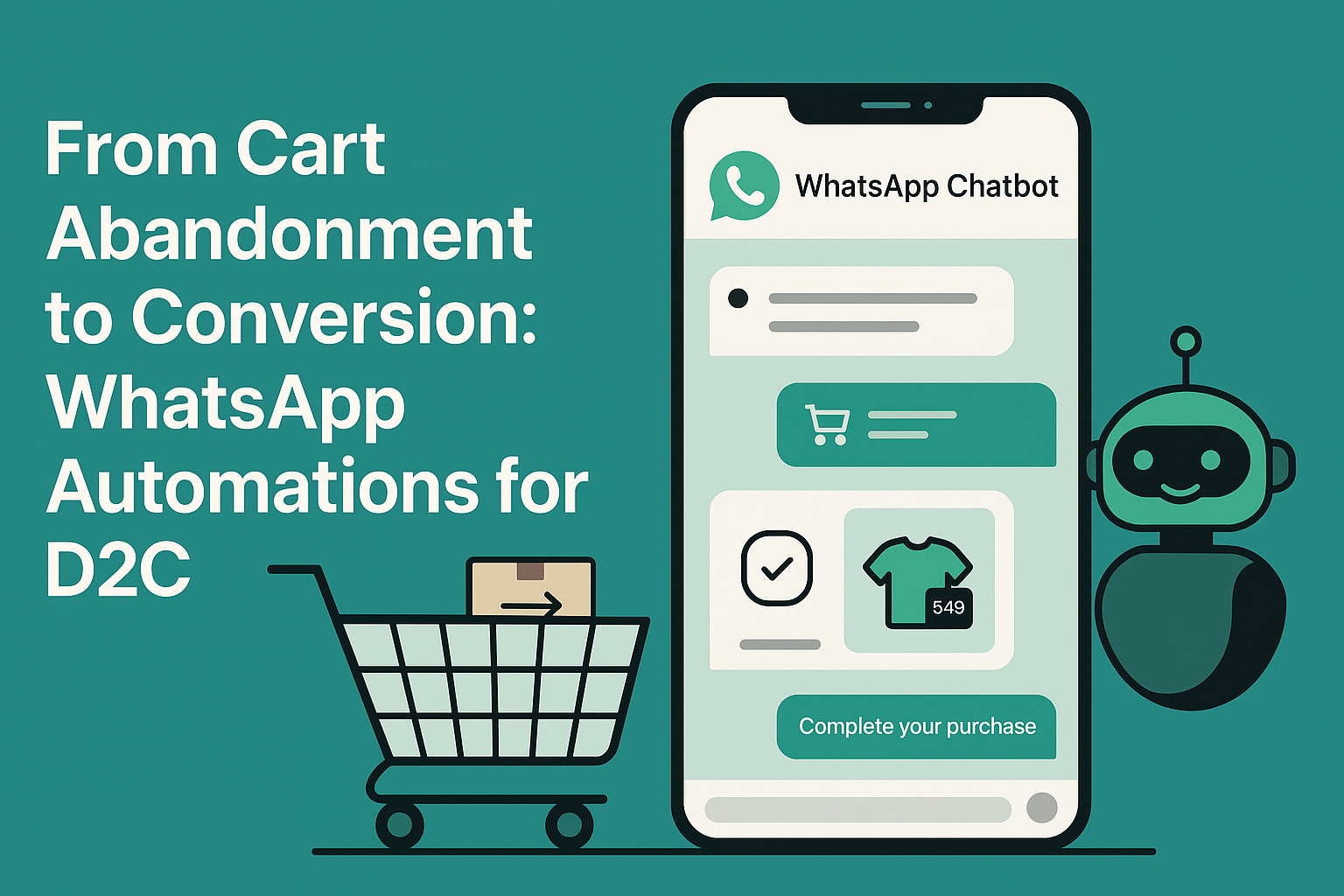
🛒 The Cart Abandonment Problem in D2C E-commerce D2C brands invest heavily in driving traffic to their online stores—yet more than 70% of shopping carts are abandoned before checkout. That’s a significant revenue leak. Why do customers drop off at the last minute? Traditional re-engagement methods like email or retargeting ads often fall short due to low open rates and banner blindness. This is where WhatsApp Automation steps in. 📱 Why WhatsApp Works for Cart Recovery WhatsApp is not just another messaging app—it’s a real-time, personal engagement channel with 98% open rates and exceptional click-throughs. For D2C brands, this means: WhatsApp delivers what email can’t: instant, human-like conversations that convert. ⚙️ Key WhatsApp Automation Flows to Convert Abandoned Carts ⏱ Abandoned Cart Reminders with Smart Timing Trigger personalized WhatsApp messages 1–2 hours after cart abandonment. Include: 🎁 Limited-Time Discounts or Triggered Offers Entice users with urgency-driven messages like: “You forgot something! Here’s 10% off if you check out in the next 30 minutes.” This strategy increases urgency and drastically improves recovery rates. 🗨️ Conversational Product Support Let users ask questions mid-purchase via chatbot automation: The bot replies instantly, increasing trust and removing purchase friction. Escalate to live chat when needed. 🤖 How TheBotMode’s WhatsApp Chatbot Powers These Automations The Botmode WhatsApp Chatbot is purpose-built for D2C ecommerce. Our platform enables: With a few clicks, you can build a full-funnel automation that runs 24/7. 📊 Real Results: WhatsApp Automation in Action One D2C beauty brand using TheBotMode recovered 31% of abandoned carts within 7 days by implementing personalized WhatsApp flows with discount triggers and FAQ automation. Another apparel brand doubled its opt-in rate by running Instagram click-to-WhatsApp ads tied directly to limited-time cart offers. 🎯 WhatsApp for Lead Generation Beyond Cart Recovery Cart recovery is only the beginning. Use WhatsApp to: Unlike cold emails, WhatsApp contacts are high-intent leads—they opted in to talk. 🚀 Getting Started: Launch Your WhatsApp Cart Automation with TheBotMode Ready to convert missed opportunities into sales? ✅ Connect your e-commerce platform✅ Design your abandoned cart flow✅ Start capturing and converting leads today 👉 Try The BotMode’s WhatsApp Chatbot Now and turn conversations into conversions. ❓ FAQs Q1: What is WhatsApp cart recovery automation?It’s an automated WhatsApp message sequence triggered when a user abandons their shopping cart, reminding and encouraging them to complete the purchase. Q2: How does WhatsApp chatbot improve lead generation?It captures user data in real time, engages them in conversation, and nurtures interest through personalized messaging. Q3: Can WhatsApp automations integrate with Shopify or WooCommerce?Yes, TheBotMode supports deep integration with Shopify, WooCommerce, and other major platforms. Q4: Is it GDPR-compliant to use WhatsApp for re-marketing?Absolutely. Users must opt-in before receiving messages, and TheBotMode ensures all flows are compliant. Q5: How quickly can I see results from cart recovery automation?Most brands see measurable improvements in conversions within the first week of implementation.
Cut RTO by 30%: Use WhatsApp to Convert COD Orders to Prepaid
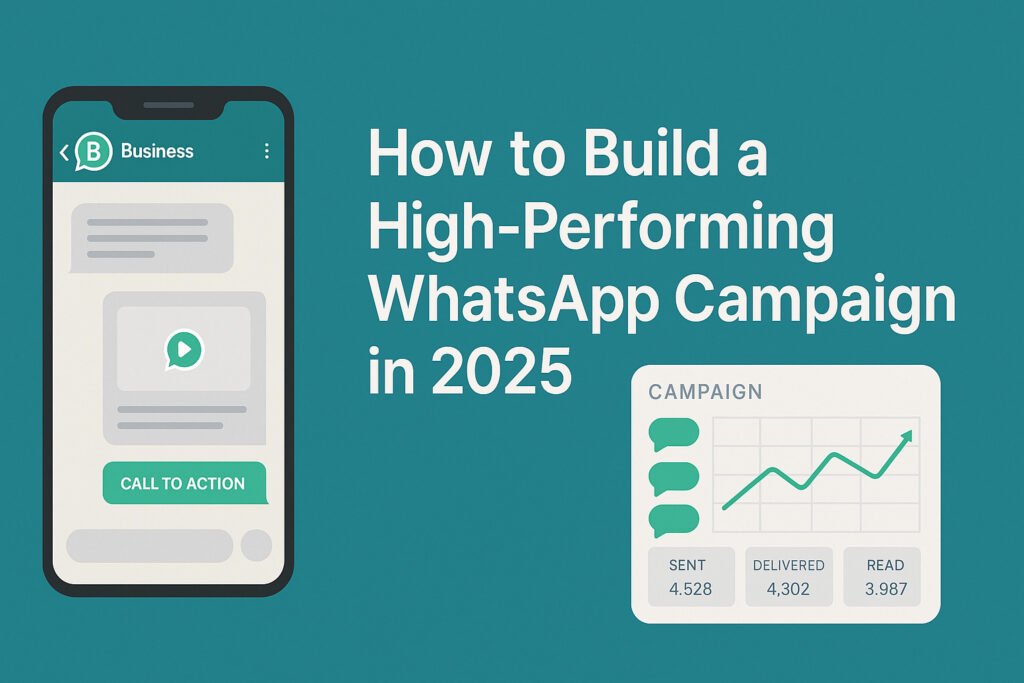
Why RTO Is a Growing Threat for D2C Brands In the fast-moving world of direct-to-consumer (D2C) e-commerce, cash on delivery (COD) continues to dominate as a preferred payment method. However, it’s also one of the biggest contributors to high Return to Origin (RTO) rates. Failed deliveries, customer rejections, and non-serious buyers result in significant losses for brands. RTO not only increases logistics costs but also ties up inventory, impacts margins, and erodes trust with delivery partners. D2C brands need a scalable way to reduce RTO while maintaining a seamless customer experience. How WhatsApp Automation Reduces RTO by 30% WhatsApp, with its 98% open rate and high engagement, is the perfect channel for turning COD into prepaid. Using smart automation flows, brands can engage customers post-order to encourage upfront payments. Here’s how: Proactive Customer Engagement Post-Purchase Immediately after a COD order is placed, send an automated WhatsApp message confirming the order and gently nudging the customer with a payment option. Offering Instant Prepaid Discounts A simple incentive—like a 5% discount or cashback on prepaid—can drive a significant number of COD customers to switch to prepaid. Real-Time Order Confirmation via Chat Use interactive WhatsApp messages to confirm whether the customer intends to accept delivery. This helps filter out high-risk RTO orders before they are dispatched. Leveraging Interactive CTAs Incorporate clickable CTAs like “Pay Now” or “Switch to Prepaid” directly in the chat. Integrate these with Razorpay, PayU, or any UPI payment gateway for seamless transactions. Step-by-Step WhatsApp Flow to Convert COD Orders to Prepaid Trigger Automation As soon as a COD order is placed on your website, an automated WhatsApp message is sent to the customer. Incentive Presentation The message clearly explains the benefit (e.g., 10% off if prepaid within the next 10 minutes), creating urgency and value. Integrated Payment Link Include a secure and pre-filled payment link so the customer can pay with a single tap, avoiding friction. Instant Payment Confirmation Once paid, the order is automatically updated to prepaid in your system, ensuring faster shipping and reducing the chance of refusal on delivery. The Bot Mode Advantage 🔗 Convert COD Orders to Prepaid with The Botmode The Bot Mode makes this entire process turnkey for D2C brands: Results You Can Expect Brands using The Bot Mode have reported: Conclusion Reducing RTO is not just about cutting costs—it’s about reclaiming revenue, improving customer satisfaction, and scaling your D2C brand efficiently. WhatsApp automation offers a high-conversion, low-friction method to convert COD orders into prepaid. With The Bot Mode, the setup is fast, results are measurable, and the impact is significant. Ready to cut RTO and boost prepaid sales? 👉 Start Your WhatsApp Prepaid Flow with The Bot Mode Today FAQs How much can I expect to reduce RTO with WhatsApp automation? D2C brands typically see a 20–30% drop in RTOs when converting even a portion of COD orders to prepaid. Will this solution work with Shopify or WooCommerce? Yes, The Bot Mode integrates directly with Shopify, WooCommerce, and other major platforms for easy deployment. What kind of incentives work best for prepaid conversions? Discounts (5–10%), free shipping, or wallet cashback work well. The key is to offer limited-time value. Is WhatsApp automation GDPR and DPDP-compliant? Yes, all customer data handling is compliant with data privacy laws including GDPR and India’s DPDP regulations.
Order Retention Made Easy: WhatsApp Strategies for D2C Brands
Introduction In the fiercely competitive D2C landscape, retaining existing customers is far more cost‑effective than acquiring new ones. With rising acquisition costs, repeat orders are the backbone of D2C brand growth—60% of revenue typically comes from returning customers.WhatsApp, with its staggering 98% open rates and near-real-time engagement, offers an ideal medium to nurture repeat purchases. In this blog, we’ll unravel high-impact WhatsApp strategies that boost customer retention, order retention, and improve your WhatsApp retention rate. Why Customer & Order Retention Matters Retaining customers boosts profitability—an increase of just 5% can improve profits by 25–95%.Given that email and SMS platforms struggle with low open rates, WhatsApp provides a competitive edge for post‑purchase and reorder communication. Why WhatsApp Works for D2C Brands Core WhatsApp Strategies for Order Retention 1. Post‑Purchase Support & Order Updates Use Business API to automate shipping notifications, tracking info, and delivery alerts. This boosts trust and engagement, shortening response times with chatbots or live agents. 2. Automated Reorder Reminders Trigger messages (e.g., Day 30 for consumables) to suggest restocking. LimeChat reports up to 3x revenue with reorder campaigns. 3. Cart Recovery Nudges With 70% carts abandoned, WhatsApp reminders with clear CTAs can recover a significant portion. Brands using recovery flows often see +35% cart conversion. 4. Personalized Recommendations & Upsells Skincare brands using WhatsApp recommended products saw a 28% increase in repeat orders. Campaigns using past behavior and AI boost conversions and CLTV. 5. Segmented Broadcast & Drip Campaigns Target based on purchase history or frequency. Strategic WhatsApp broadcasts can cut churn, grow CLV, and maintain engagement at 7–10 messages/year. Best Practices & Automation Tips Seamless WhatsApp Integration: Tech & Tools Measuring WhatsApp Retention Rate & ROI Aim for 98% open rate, 45–60% CTR, and 3× ROI.Compare repeat order rates among customers engaged on WhatsApp vs. others. For instance, reorder reminders can trigger 22%+ reorders, while conversational support yields 3.5% of total orders per brand. Conclusion & Call to Action WhatsApp isn’t just a chat app—it’s a powerful channel to retain customers, drive repeat orders, and boost CLV. From automated reorder nudges to recovery flows and personal upsells, these strategies help D2C brands stay connected and increase revenue.🎯 Next step: Start with one strategy—like sending reorder reminders on a 30-day timer or launching your first cart recovery flow.Want help setting up flows and measuring ROI? Contact us at TheBotMode.com for a free consultation or demo 🚀 FAQs 1. Can WhatsApp fully replace email/SMS for order retention? No—each serves a distinct purpose. Use WhatsApp for high-touch, time-sensitive and conversational touchpoints; retain email for resolution-heavy or detailed content. 2. How frequently should I send WhatsApp reminders? Follow the “low frequency, high relevance” model—7–10 quality messages per year per customer ensures retention without fatigue. 3. What opt-in method works best? Use double opt-in via checkout or welcome emails, supplement with SMS/website CTAs and click-to-WhatsApp buttons. 4. How do I implement 1‑click reorders? Use API-triggered reorder workflows: find reorder date from first purchase + customer data, then include a purchase link with pre-filled carts . 5. Can I track ROI from WhatsApp strategies? Yes—integrate UTM parameters or unique coupon codes in messages, and calculate based on repeat orders, AOV uplift, and cost per chat/flow.
How to Build a High‑Performing WhatsApp Campaign in 2025

Introduction WhatsApp has emerged as one of the most impactful marketing channels in 2025, boasting unmatched open rates, real-time interactivity, and a massive global user base. For businesses looking to drive conversions and deepen customer relationships, creating a high-performing WhatsApp campaign is no longer optional—it’s essential. This guide will walk you through every step of building a successful campaign using the latest tools, strategies, and compliance standards. 1. Understanding WhatsApp Campaign Types (Promotional, Transactional, Conversational) WhatsApp campaigns fall into three main categories: Each type requires different message formats and approval via pre-approved templates for outbound messages. 2. Getting Started: API Setup & Access Businesses can choose between: API Requirements: You can use cloud-based or on-premises API solutions. In 2025, Meta has simplified onboarding through providers like TheBotMode. 3. Trend Spotlight: What’s New in 2025 4. Define & Segment Your Audience Use your CRM, website, or click-to-chat ads to build your opt-in list. Segment audiences by: Segmentation ensures relevance and improves engagement. 5. Template Design & Personalization Design templates that resonate with users: All outbound templates must be approved before use via Meta’s template review. 6. Timing & Scheduling Strategies Ensure frequency capping to avoid spam and high opt-out rates. 7. Rich Media & Interactive Messaging Enhance user experience using: Use multimedia to highlight USPs and product benefits quickly. 8. Automation vs Human Touch Leverage chatbots for: Hand off to human agents for: This hybrid model maximizes efficiency and customer satisfaction. 9. Compliance & Quality Control WhatsApp marketing is tightly regulated: 10. Analytics & Performance Optimization Track the following metrics: Use analytics dashboards provided by TheBotMode or Meta to refine your approach continuously. 11. Case Examples & Tools to Try Popular tools include: Use Cases: 12. Future Outlook: Ads & Monetization on WhatsApp WhatsApp will soon support: Integration with Meta’s ad suite allows for end-to-end user journeys starting from social ads to WhatsApp. Conclusion & Next Steps WhatsApp campaigns are indispensable in 2025. With the right API access, strategic segmentation, interactive content, and robust analytics, businesses can drive unmatched engagement and conversions. Next Steps: FAQs Do I need API or can I use the App? For large-scale or automated campaigns, API is required. The app is sufficient for basic manual outreach. How many messages can I send per day? Message limits depend on your quality rating and verified status. API tiers define your daily cap. Is WhatsApp campaign marketing legal in India? Yes, if you follow opt-in rules and DPDPA data protection laws. Can I add images and videos to messages? Yes, WhatsApp supports rich media in both transactional and promotional messages via the API.
WhatsApp Coexistence: Boost Your Retail Business with This Powerful Feature
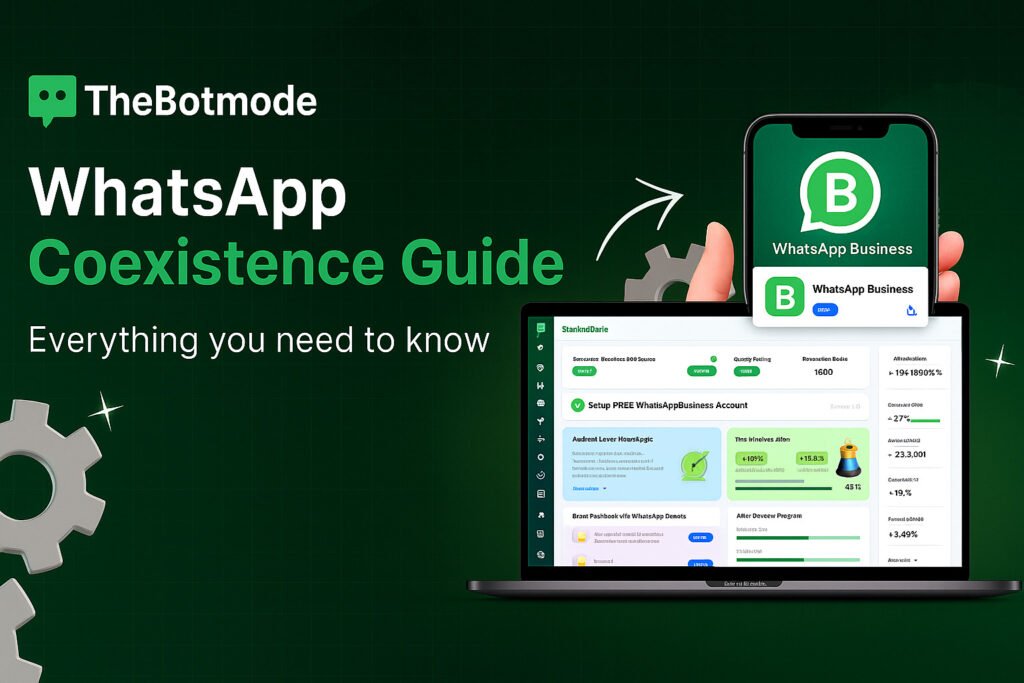
Hey there, retail champions! You already know WhatsApp is a lifesaver when it comes to communicating with your customers. Now, WhatsApp is rolling out a new feature called WhatsApp Coexistence (Coex), which lets you manage personal interactions and automation seamlessly using the same WhatsApp number. So, What Exactly is WhatsApp Coexistence? Think of Coexistence as your new assistant—it lets you keep the warmth of personal conversations through the WhatsApp Business App, while still harnessing the power of automation and CRM integrations via the WhatsApp Business Cloud API. One number, dual power! Why Retailers Will Love WhatsApp Coexistence Get Started in Four Easy Steps 1.Quick Update & Verification: Simply update your WhatsApp Business App (version 2.24.17+) and verify your business account on Meta. 2.Connect to Facebook: Link your WhatsApp Business App to your Facebook Page. 3.Activate Cloud API: Turn on Cloud API through the Meta Business Manager portal. 4.Easy Sync with QR Code: Use a QR code provided by WhatsApp to effortlessly sync your conversations. A Few Things to Keep in Mind Practical Ways Retailers Can Benefit Final Words WhatsApp Coexistence isn’t just another tech feature—it’s your new business ally. It perfectly blends personal touchpoints with efficient automation, allowing your retail business to grow without losing the human touch. Ready to take your retail customer experience to the next level? Drop your thoughts below and let’s chat!
Using WhatsApp Broadcasts to Launch New Products – A Step-by-Step Guide 2025
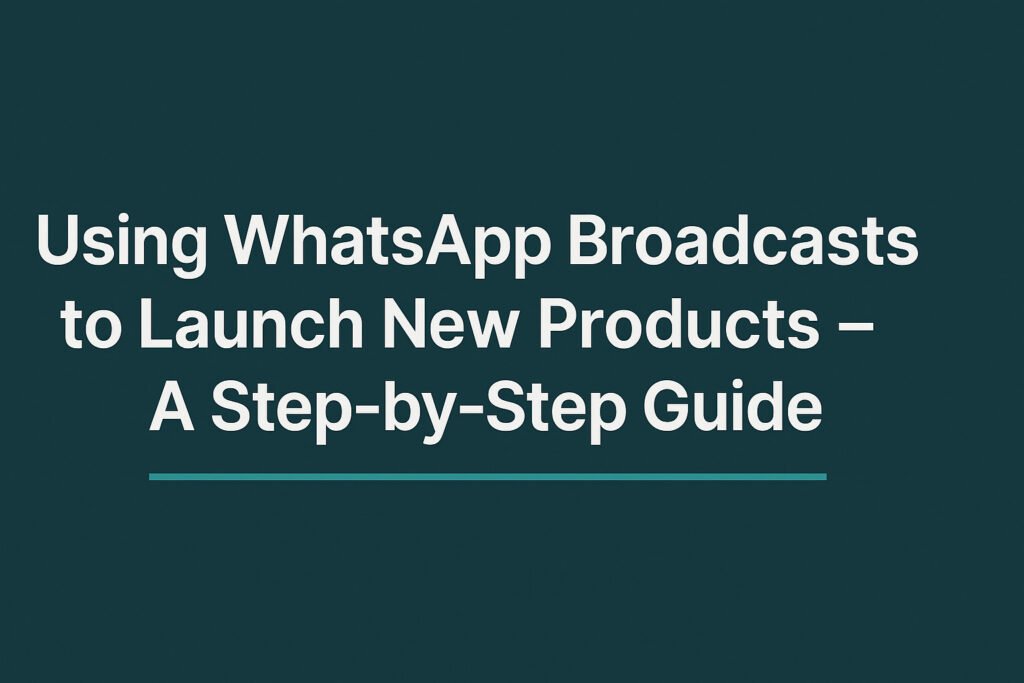
Launching a new product is a pivotal moment for any D2C brand. In 2025, WhatsApp Broadcasts have become one of the most effective tools for grabbing attention and driving conversions. With industry-leading open rates and instant engagement, WhatsApp can turn a typical product drop into a high-impact launch event. In this guide from TheBotMode, you’ll learn how to strategically plan and execute a winning product launch using WhatsApp Broadcasts. Step 1: Build a Qualified WhatsApp Subscriber List Before sending any broadcast, you need a compliant and engaged audience. WhatsApp requires explicit opt-in to receive business messages via the API. Pro tips to grow your list: Step 2: Segment Your Audience for Relevance Segmenting your list ensures the message feels personalized and timely, boosting engagement. Example segments for a skincare launch: TheBotMode makes this seamless with dynamic filters and auto-tagging based on customer behavior. Step 3: Design a Launch Sequence with Timed Broadcasts Avoid sending everything at once. A staggered broadcast flow builds anticipation and nurtures buyer intent. Suggested 3-day WhatsApp launch funnel: 🛍️ Add CTA buttons like [Shop Now], [View Product], or [Claim Offer]. Step 4: Use Rich Media to Tell a Visual Story WhatsApp supports various media formats that can significantly enhance your product storytelling. Effective formats include: Use storytelling to show why this product matters—not just what it is. Step 5: Create Urgency with Limited-Time Offers WhatsApp is perfect for time-sensitive marketing. Create urgency to push conversions. Urgency-driven elements: Enable Quick Reply Buttons to capture fast responses and qualify interest. Step 6: Track Performance and Optimize in Real-Time Monitor key performance metrics post-broadcast using TheBotMode’s campaign analytics. Essential metrics to track: Analyze what worked—and optimize your next campaign accordingly. Step 7: Follow Up and Nurture Post-Launch Your launch doesn’t end after the broadcast. Keep the momentum going. Follow-up strategies: You can automate this flow via TheBotMode’s smart sequences. Conclusion Using WhatsApp Broadcasts to launch new products gives D2C brands an edge—thanks to real-time engagement, high visibility, and personalized communication. When combined with automation tools like TheBotMode, you can transform your product launch into a high-conversion experience. FAQs Q. What is the maximum number of users I can send a WhatsApp Broadcast to? With the WhatsApp Business API, there’s no hard limit—as long as users have opted in. Make sure your number is verified and maintain a high-quality rating. Q. Can I send a broadcast to users who haven’t messaged me? No. WhatsApp strictly requires opt-in before initiating any business communication. Q. How is a WhatsApp Broadcast different from a group message? A broadcast sends messages individually. Recipients don’t see each other, and their replies are private. Q. Is WhatsApp better than email for product launches? WhatsApp has much higher open and response rates, making it ideal for launches. However, combining email and WhatsApp offers the best omnichannel experience.













